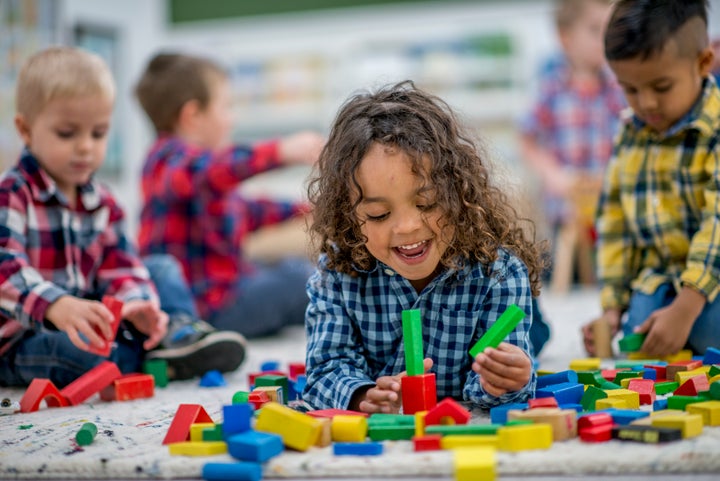
On Tuesday, Ontario announced that child care centres in the province will be allowed to re-open starting this Friday.
That doesn’t necessarily mean they’ll all choose to open, just that they can.
For many parents, the response was a resounding “FINALLY.” But once that initial relief lifted, a lot of questions remain about how this will work and what it will actually mean.
“It’s a stressful decision,” said Jennifer Fane, an instructor at Capilano University who recently got her doctorate in early childhood care and education. She’s also the mom of a two-year-old who’s now at home with her in B.C. due to the coronavirus. “I understand this on a whole lot of fronts,” she said.
Many Ontario parents are now trying to figure out how re-opening will work, and making the difficult decision about whether or not they feel comfortable sending their kids to daycare centres. Here are some of the questions parents are facing.
How many people will be allowed in re-opened daycares?
Ontario will implement a 10-person cohort system for daycares. Groups of no more than ten people per room, including both children and staff, will be put together. That means kids won’t see or socialize with anyone outside of their small group, in order to limit the spread of the virus. It also means that if there is an outbreak, it will make contact tracing easier.
What other changes will be implemented?
The daycare centres that choose open will screen all kids and staff members before they go in, will remove toys that can easily spread germs and can’t easily be washed, will thoroughly clean the facilities before opening and throughout the day, won’t allow visitors, and will be required to provide a detailed plan of what they intend to do if there is an outbreak.
Will parents still have to pay if they don’t send their kids back?
No. The government has said they expect many parents will opt to keep their kids at home for the time being, and that parents who don’t send their kids to daycare will be able to keep their spots and won’t have to pay a fine.
Watch: Ontario premier Doug Ford talks about re-opening childcare centres. Story continues after video.
How long will spots be held?
We don’t know for sure. A spokesperson for Ontario’s education minister told HuffPost Canada that there isn’t a set date for how long these spots will be held — it will depend on when or if the emergency order is extended. Ontario’s current emergency order is in place until June 19.
Will parents still be eligible for CERB if they don’t send your kids back?
Yes. A representative for employment minister Carla Qualtrough told HuffPost Canada that a worker who is staying home during the pandemic to take care of a child or dependent still qualifies for CERB.
How have daycare responded?
So far, we know that Toronto Children’s Services has said it will not open its care centres right away. The group said it will continue operating eight centres for emergency child care, and will do so until June 26.
HuffPost Canada hasn’t yet heard back from other daycare centres.
How can we get young children to social distance?
We can’t — and that’s actually for the best, Fane said.
“Not only is that not reasonable, that it would greatly impact young children’s sense of safety and security and well-being,” she said. “It’s actually really essential that social distancing doesn’t happen in child-care centres because of the of the negative impacts that would have.”
Kids under the age of eight likely don’t have a very detailed understanding of what exactly is going on right now, Fane explained. The concept of a pandemic is both very complicated and very scary to a little kid.
“Short of scaring children by saying, ‘If you touch someone you will get sick,’ there’s really no way to communicate the children why they can’t interact socially with their friends and with their childcare providers the way they did before,” she said.
This is somewhat similar to what’s been going on at emergency childcare centres that are providing care for frontline workers. There, the groups are much larger — the maximum amount of children and staff is 50 people — but kids are encouraged to play in small groups.

Essentially, the only way to get very young kids to comply with the rules is to scare them, which isn’t a great option. Doing that would “really impact on children’s agency and their ability to relate to peers and caregivers,” she said.
“It’s really important that children are able to interact with some sort of normalcy and in the settings in which they generally have high levels of agency of what and how they’re able to move their bodies and interact with those around them.”
Fane said Ontario’s decision to implement “cohorting” sounds like a reasonable approach to get around this issue. Kids can socialize as usual, just with fewer people at a time.
What are some of the benefits to sending kids back to daycare?
Even the best-intentioned parent can’t provide the same opportunities for learning and development that a kid can get from an educational daycare experience, Fane said. Social and emotional learning and development opportunities that kids get from educators, and from being around other kids their age, can’t really happen at home.
Fane also hopes parents look not just at what’s best for the child, but for the family as a whole.
“While children are are safe at home with parents, many — I would say most —parents are very stressed,” she said. “If having children at home is becoming detrimental for the overall well-being of the families like parental stress, parental ability to earn to make money to return to work, then there certainly would be benefits about children going back to childcare.”
And of course, for some kids, daycare is a safer place than home. Families struggling with abuse, or other challenges will likely welcome the option to send kids back to daycare, Fane said.
What are some of the potential drawbacks?
Re-opening does come with risks. The data does show that children are less likely to contract COVID-19 than adults: recent information from Public Health Ontario found that children have between one and 10 per cent of coronavirus cases worldwide, and that their infections are usually more mild.
But that doesn’t mean children can’t get it or in some cases even die from it. So, it’s a risk parents have to weigh, in the way that parents weigh risks about their children all the time.
Some parents might not want to pay the very high child-care fees, which is another valid reason for keeping kids home, Fane said.
What are some of the circumstances where you absolutely shouldn’t send your kid back?
If your child or someone in your household has an immune deficiency, or is otherwise more susceptible to getting very sick if the contract COVID-19, it may be best to exercise caution.
And if sending your kids back to daycare does give you severe anxiety, there’s no reason to force it, Fane said.
“Some people are just really, really scared,” she said. “If the idea of sending your child is causing acute stress, then I would certainly suggest really thinking about the overall needs of your family.” There’s no need to rush it if you don’t feel comfortable.
What else should parents keep in mind?
Even very young kids can pick up parental stress, Fane said. It’s a good idea to go with the choice that will reduce your family’s stress level overall, whether that means keeping kids home because you’re nervous about contracting the virus, or sending them to daycare because being around your kid 24/7 is making you crazy.
“Children do best in households that are happy and have lower levels of stress,” she said. So essentially, “it’s OK, whichever decision you make.”
“Just feel confident in that decision that you’re making, and that it’s not just what’s best for your child, but also what’s best for your family unit, because children thrive in families that that are thriving.”
Also on HuffPost: